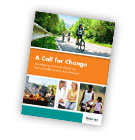 3 in 4 Americans say that out-of-pocket costs are the main reason they decide whether or not to seek preventive care, in A Call for Change: How Adopting a Preventive Lifestyle Can Ensure a Healthy Future for More Americans from TeleVox, the communications company, published in June 2013. TeleVox surveyed over 1,015 U.S. adults 18 and over.
3 in 4 Americans say that out-of-pocket costs are the main reason they decide whether or not to seek preventive care, in A Call for Change: How Adopting a Preventive Lifestyle Can Ensure a Healthy Future for More Americans from TeleVox, the communications company, published in June 2013. TeleVox surveyed over 1,015 U.S. adults 18 and over.
That’s the snapshot on seeking care externally: but U.S. health consumers aren’t that self-motivated to undertake preventive self-care separate from the health system, either, based on TeleVox’s finding that 49% of people say they routinely exercise, and 52% say they’ve attempted to improve eating habits.
About one-half of the people polled said they are currently managing a chronic illness such as hypertension (high blood pressure), heart issues, diabetes or cancer. And 1 in 2 people is taking at least one prescribed medication daily. But,
- Only 1 in 3 people in the U.S. have spoken with their personal doctors about their medical history and risk factors for diseases
- In the past 2 years, only 26% of people have been screened for diabetes
- 33% have had cholesterol checks.
So it’s no surprise that only 1 in 4 health consumers gives herself an “A” for preventive health care.
TeleVox talks about wellness for women and men, noting that,
- For women, it’s important to “find the beauty in prevention,” noting that lowering stress, eating more healthy foods, taking care of skin and teeth, and taking regular exercise can bolster both physical appearance and health.
- For men, prevention is a “BIG” problem, TeleVox observes, with 35% of men obese and, as a result, at greater risk for obesity, heart disease, and certain cancers. Prevention is a lower priority among men than women, the survey found.
Health Populi’s Hot Points: Of particular shock to me was that only 33% of Baby Boomer women have received a mammogram, and only 24% of Boomer men have received a prostate exam.
These are very low screening numbers. TeleVox’s data indicates that the cost for preventive screenings, and preventive services overall, has been a barrier to people accessing these services early before disease onset.
Nearly all people say prevention is important: yet, in every age group, acting on that belief is scant. The cost barrier for prevention should be largely addressed through the implementation of the Affordable Care Act. Job #1 for public health professionals, and health care providers keen on prevention and population health management, will be to communicate the fact that costs for (most) people should be covered by health reform. This theoretically would take the cost barrier down, leading to more people seeking more preventive care.
That’s the theory. However, will people — say, the 2 in 3 women not currently going for mammograms when they’re part of a whole-health strategy – change their personal health workflows to schedule and actually receive the screening? We can ask the same question for prostate exams and men who avoid the tests.
Making prevention cool, beautiful, smart – whatever motivates the prevention-poor patient – is the must-do for health plans, providers, payors (employers, unions and government health insurance sponsors). And to do that requires asking people the very question: what will lead you to actually seek prevention. While cost is clearly a barrier, there are other personal obstacles – values, fears, vanity, fear and others — that prevent people from seeking prevention. Getting real about these will help the health system avoid another Field of Dreams challenge of building the preventive strategy, and paying for it — without people coming to it.




 Thank you FeedSpot for
Thank you FeedSpot for